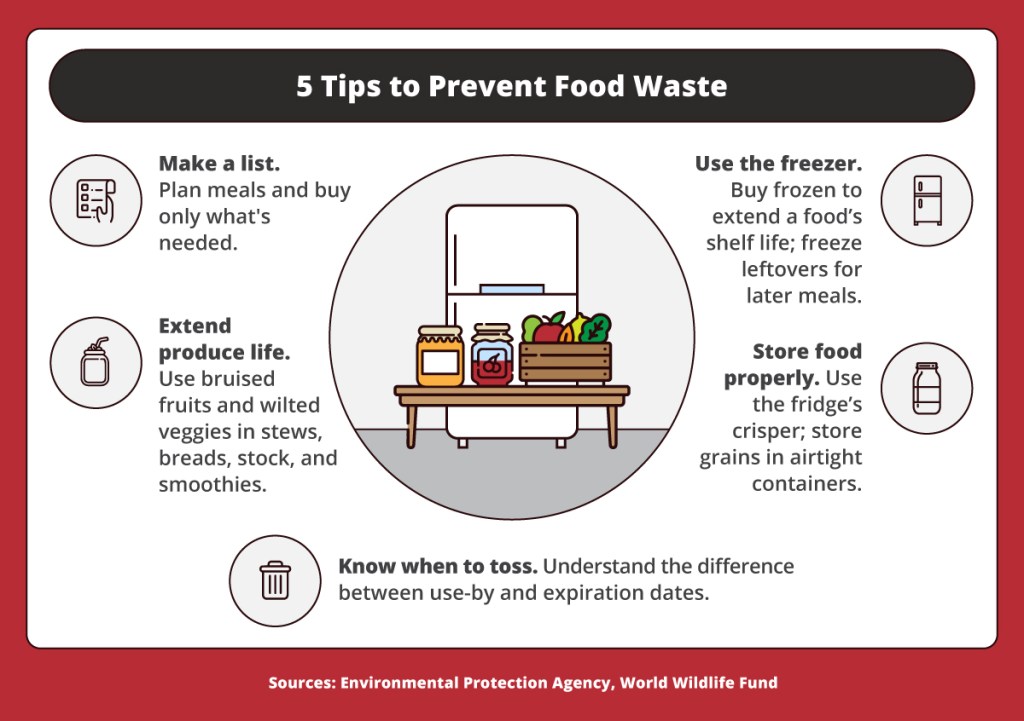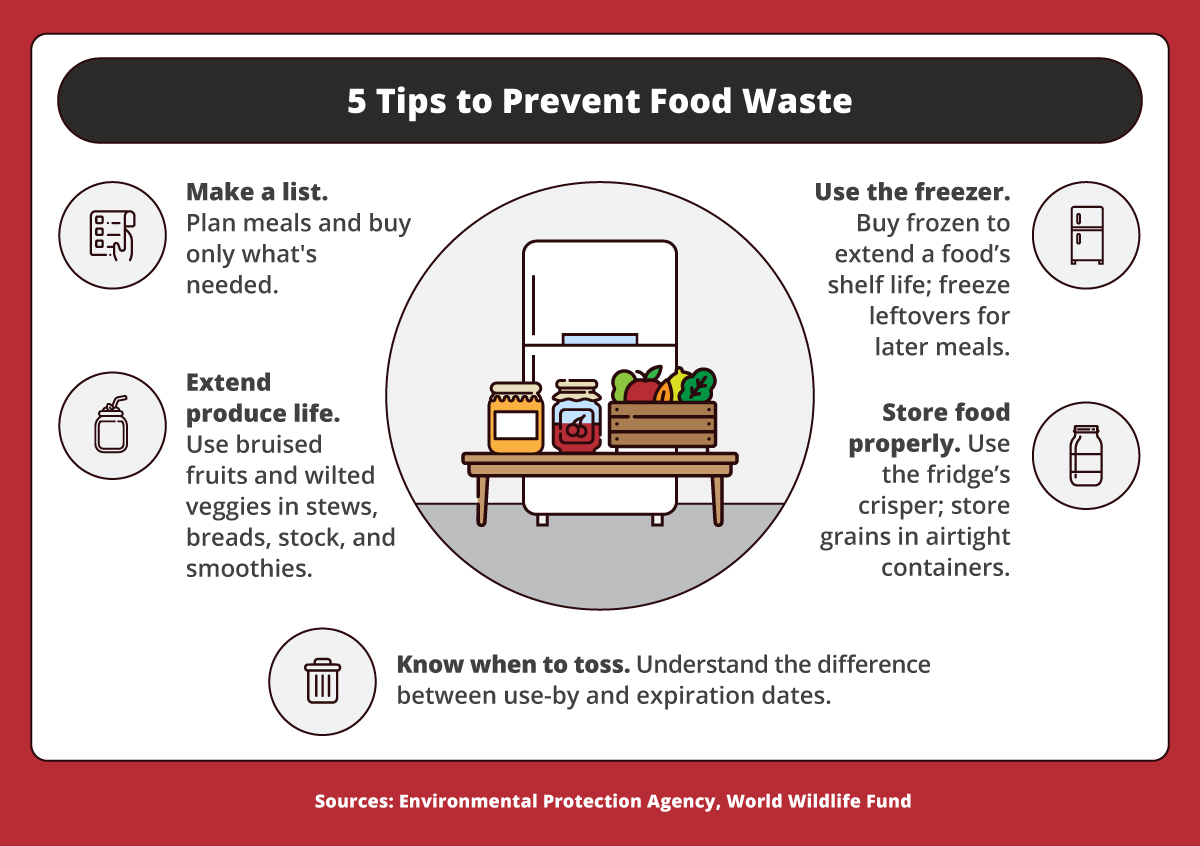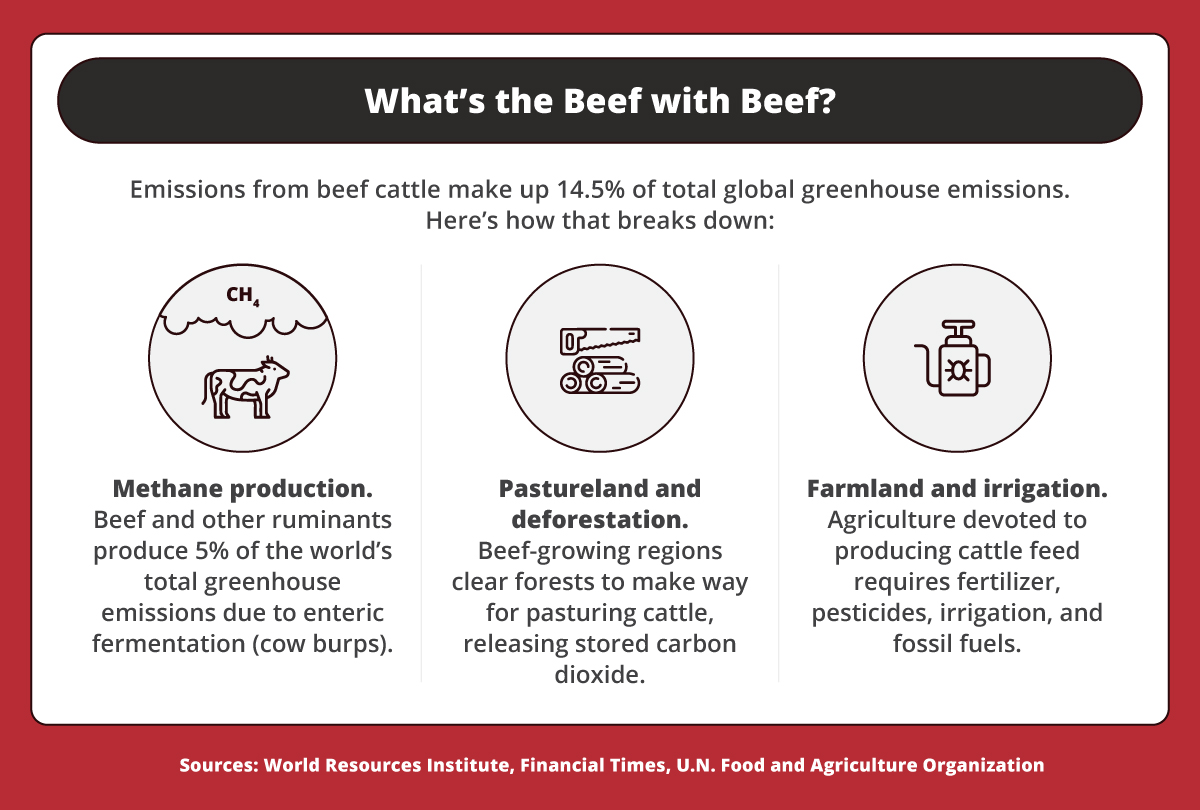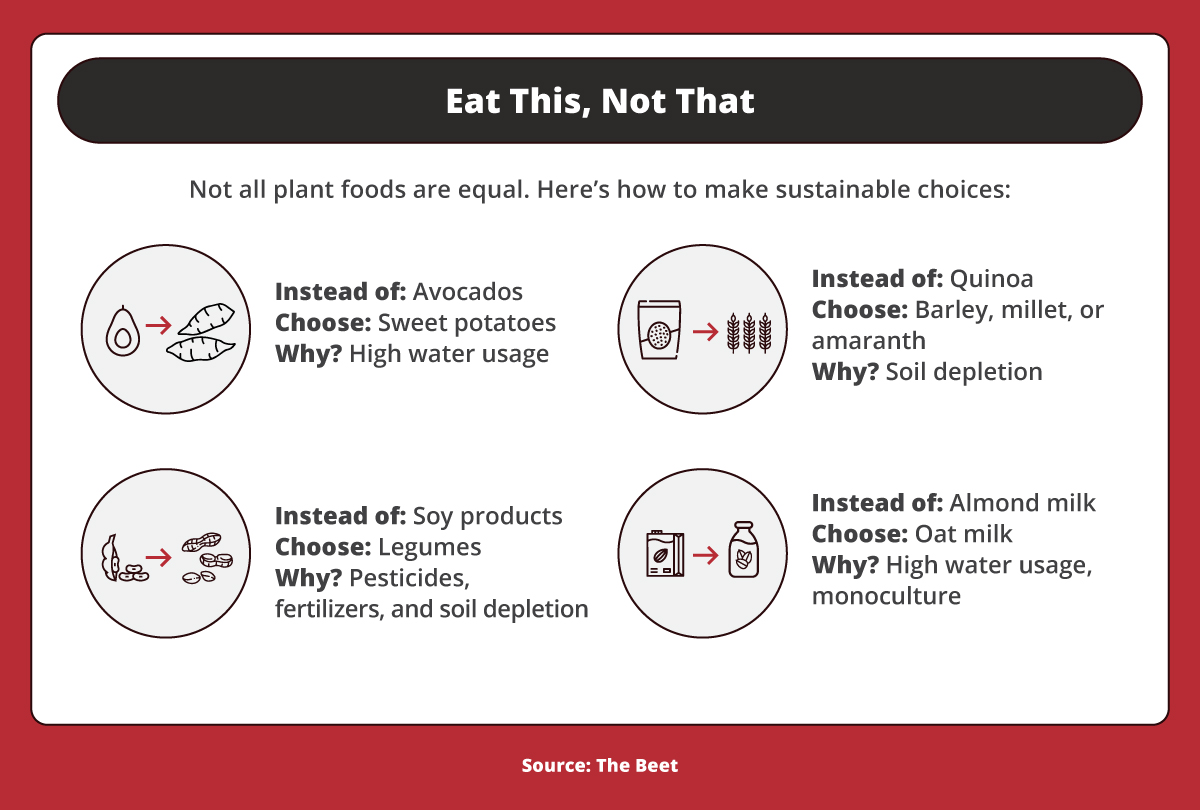Guide to Sustainable Eating: Improving Your Health and the Planet

Table of Contents
- What Is Sustainable Eating?
- Sustainable Food Practices
- Sustainable Eating Habits
- How to Eat Sustainably
- Sustainable Food Choices and Best Practices
- Examples of Sustainable Foods
Does the way we eat affect the environment? Scientists say yes. Diets high in animal protein and certain crops can increase water usage, contribute to soil depletion, and release methane and other fossil fuel emissions into the atmosphere. Large-scale agriculture and livestock husbandry rely on highly resource-intensive farming practices. However, eating a sustainable diet can mitigate these impacts and help lessen the impact of agriculture on the environment.
The more individuals adopt the principles of food sustainability, the more it can help reduce the impact of climate change on the environment as well as on our health and well-being.
What Is Sustainable Eating?
Sustainable eating means choosing foods based on the impact of their production on soil, water consumption, pesticides, land clearing, greenhouse gasses, and fossil fuel usage. People who try to eat sustainably choose foods that are produced by farming practices that are the least harmful and the most beneficial to the environment.
Choosing to eat sustainably doesn’t just have an environmental impact. It’s also widely recognized as more nutritious than a conventional diet.
Components of a Sustainable Diet
A sustainable diet consists mainly of vegetables, legumes, whole grains, certain nuts, and fruits. It avoids most processed foods such as sugar and refined grains. Eating sustainably can include meat and fish that are grown and harvested in environmentally conscious ways. However, red meat, primarily beef, is not considered sustainable, since it contributes heavily to methane emissions and land deforestation. Dairy farming is also considered unsustainable due to methane emissions.
Benefits of a Sustainable Diet
Eating sustainably is less expensive than a diet rich in meat, since legumes and grains are less costly to produce than livestock and require fewer resources. These foods are high in nutrients. They can help people avoid chronic illnesses such as high blood pressure, which has been linked to a diet high in red meat and processed foods.
Sustainable Food Practices
Sustainable food practices start with understanding the impact of modern agriculture on climate change and the environment. Only then can people make informed choices about the food they buy and consume. As with any new practice, it can be difficult to know where to begin. It can also be hard to know if adopting sustainable eating as part of the solution to climate change can make a difference.
It’s not possible to discuss sustainable food practices without talking about sustainable agriculture. Some sustainable choices, such as eating little to no red meat, can reduce methane emissions by reducing demand for beef. Conventionally grown vegetables, fruits, and nuts also require a lot of water and pesticides.

These five tips can help minimize waste, according to the Environmental Protection Agency and World Wildlife Fund: 1. Make a list. Plan meals and buy only the necessities. 2. Use the freezer. Buy frozen to extend a food’s shelf life; freeze leftovers for later meals. 3. Extend produce life. Use bruised fruits and wilted veggies in stews, breads, stock, and smoothies. 4. Store food properly. Use the fridge’s crisper; store grains in airtight containers. 5. Know when to toss. Understand the difference between use-by and expiration dates.
The Scope of the Problem
Agriculture accounts for 40% of the world’s methane emissions, according to the United Nations’ Global Methane Assessment. This largely comes from raising livestock and rice cultivation. Methane is one of the leading causes of global warming. One result of a warmer climate? Rising temperatures reduce crop yields, which can increase food insecurity around the world.
In 2020, U.S. agriculture emitted 669.5 million metric tons of carbon dioxide, nitrous oxide, and methane, according to the Environmental Protection Agency (EPA). Cattle, corn, and soybeans make up the top three farm products in the U.S., all of which are resource-intensive and have a high carbon footprint. Cattle and soybean production are also the largest drivers of deforestation in the Amazon basin, which increases carbon in the atmosphere.
Another example is almond farming in California. Almond production is a major user of water in the state. Producers use bees to pollinate their trees, and bees are under environmental pressures from pesticides and other factors, causing die-offs. Climate change-caused drought is causing conflict between agriculture and other water users. Almond producers are adopting sustainable practices, which may help to ease some of these effects.
Can sustainable food production, also known as climate-smart agriculture, meet the demand in a world that’s expected to reach a global population of 8.6 billion in 2030? The answer may be: It’s going to have to.
Sustainable Farming
Sustainable agriculture dates back thousands of years. Cultures around the world developed best practices for their regions based on soil and water characteristics. When scientists conduct experiments on the effectiveness of these practices, the results are promising. They can help reduce the carbon footprint of agriculture and counter the threat of a warming planet.
When farmers take sustainability into account, they can incorporate many farming practices that add biodiversity to the environment; reduce pesticides, fertilizers, and water usage; and decrease their carbon footprint. Not all these practices work for every farm, of course. Some of these practices include:
- Reducing reliance on chemical fertilizers. Farmers are using methods such as mixing manure or compost directly into the soil, reducing the need for man-made fertilizers, which can pollute groundwater.
- Planting crops that add nutrients to the soil. Farmers can plant clover or legumes to add nutrients to the soil, increasing the crop yields.
- Planting cover crops. Cover crops slow erosion, act as natural pesticides, and improve water use.
- Implementing agroforestry. This involves planting crops in forests, allowing the trees to provide shade and improve biodiversity.
- Sustainable fishing. Sustainable agriculture practices also include harvesting fish to prevent overfishing and reducing bycatch.
- Raising beef on grass. Raising cattle on grass until slaughtered can reduce the impact of finishing cattle with high-resource-grown feed. It also produces leaner, healthier meat.
Sustainable Choices
Based on this information, individuals can make choices at the grocery store or farmers market that support sustainable food production. As more people approach food buying with this knowledge in mind, it may encourage a shift toward sustainable farming. With that in mind, here are some tips for grocery shopping.
- Smart shop the grocery aisle. Navigate toward plant foods, choose meat sparingly, and avoid processed foods.
- Bring bags from home. Reusable totes or upcycled bags help reduce plastic waste.
- Buy in bulk. Grains, legumes, nuts, and dried fruits can be cheaper in bulk and can be portioned out later.
- Read labels. Was the fish sustainably harvested? Is the beef grass fed? Where does the food come from?
- Don’t overbuy. Try to avoid food waste and only buy as much as necessary so it can be consumed before it goes bad.
Sustainable Eating Habits
Adopting sustainable eating habits means taking a well-rounded approach to food. Besides being mindful of how food is produced, it’s important to take food storage and food waste into consideration. It can mean being adventurous about trying new foods and new recipes. Daily meals may require more thought and meal prep until the habit becomes ingrained.
Sustainable eating habits include:
Choose a Plant-Based Diet
A plant-based diet is more sustainable than a diet heavy in animal protein or processed sugars. This doesn’t mean that everyone must become vegan or vegetarian. A sustainable diet can include sustainably harvested seafood, and beef and dairy in small quantities. A diet rich in vegetables, fruits, legumes, and nuts is high in nutrients and reduces risk of heart disease and cancer.
Buy Local and in Season
The general wisdom is that buying locally and in season are important parts of a sustainable diet. The real answer is more complex.
Emissions from food transportation are only a tiny part of food production’s carbon footprint, so it’s possible to eat sustainably without going to the local farmers market. The big exception is food that travels by air. These are often fresh berries and vegetables with a short shelf life.
Buying food in season tends to be more sustainable. Food grown outdoors in season requires less energy and water than food cultivated in artificial, controlled environments. It may often be more nutritious and tastier. Eating seasonably can also lead to a more varied diet as different fruits and vegetables become available.
Reduce Food Waste
The Food and Drug Administration (FDA) estimates that 30%-40% of all food produced in the U.S. is wasted — roughly 133 billion pounds of food in 2010. All the resources that went into producing that food also went to waste. Therefore, reducing food waste is a crucial habit. Methods include using vegetable scraps (and bones, if eating meat) to make soup stock or broth and freeze for later. Buying less at the grocery store can also prevent food waste. Understanding the difference between “use by” and “sell by” dates can help avoid throwing out perfectly good food.
Choose Sustainable Packaging
Styrofoam meat trays covered in plastic wrap are part of unsustainable food production. This packaging is made of fossil fuels and can’t be recycled or composted, adding to climate change and environmental degradation. Sustainable food packaging can be made from microbial biodegradable polymers that keep food fresh and safe until consumed.
How to Eat Sustainably
Successfully transitioning to a sustainable diet can be a long process, but it doesn’t have to be a difficult one. Not every change will work for a particular individual. Food choices are intensely personal. Food allergies and intolerances will impact sustainable options. Ready to get started with eating sustainably?
Start Small
Start with small changes. Commit to one meatless dinner a week, then daily. Identify recipes and meal plans that make sense for individual budgets and households. Research alternatives to old favorites.
Replace Red Meat
Maybe that means exchanging hamburgers with a veggie burger and topping it with favorite burger toppings. Remember that beans, lentils, and peas aren’t the only sources of protein. Nuts and certain plants such as broccoli and asparagus are high in protein.
Note that there is some question on the sustainability of plant-based meat replacement products, especially with regard to water usage and emissions.

Emissions from beef cattle make up 14.5% of total global greenhouse emissions. Here’s how that breaks down, according to the World Resources Institute, Financial Times, and the U.N. Food and Agriculture Organization: 1. Methane production. Beef and other ruminants produce 5% of the world’s total greenhouse emissions due to enteric fermentation (cow burps). 2. Pastureland and deforestation. Beef-growing regions clear forests to make way for pasturing cattle, releasing stored carbon dioxide. 3. Farmland and irrigation. Agriculture devoted to producing cattle feed requires fertilizer, pesticides, irrigation, and fossil fuels.
Reconsider Seafood
Salmon is a healthy fish chock full of omega-3 fatty acids and other nutritional goodness. However, it’s mostly farmed, and has to be flown to most markets. Mussels, scallops, clams, and other shellfish are more environmentally sustainable than salmon and other fish that may be farmed or overfished.
Add Mushrooms
Mushrooms are high in protein and other nutrients. They are also a source of umami, which adds extra flavor to foods. There are many dozens of varieties of mushrooms, and they can be bought fresh or dried for an extra flavor punch.
Remember Packaging
A great deal of food packaging is designed to catch the eye rather than preserve food from spoilage or contamination. Choosing compostable packaging and avoiding foods wrapped in plastic contribute to sustainable eating. Bring reusable bags to prevent plastic from entering the environment, where it can harm animals and plant life. Other packaging choices include reusable mugs instead of paper coffee cups and buying in bulk.
Be Adventurous
Eating sustainably should be tasty. Try new foods and new recipes and choose favorites. Spices and sauces open up a new world of food options. By shifting the focus of meals away from meat and toward other nutritious foods, sustainable eaters can enjoy a wide variety of cuisines.
Sustainable Food Choices and Best Practices
The following sustainable food practices can stretch food dollars, reduce food waste, and increase the nutritional bang for the buck.
Meal Plans
Before going to the grocery store, start with a meal plan. Meal planning is a way to save on costs and make sure food doesn’t go to waste. Meal planning can also help prevent impulse buys. It makes it easier to cook at home rather than going out to dinner at the last minute, which can be twice as expensive as eating in.
Advance Meal Prep
Sometimes, the last thing someone wants to do at the end of a long day is cook dinner. That’s where advanced meal preparation comes in. Slow cookers and multi cookers are efficient timesavers that help ensure food doesn’t go to waste. Some other options are choosing one day to cook for the week and freezing meals. While this may seem more about efficiency than sustainability, remember that throwing food out is a huge problem and a terrible waste of resources.
Organic vs. Non-Organic: Which Is Better?
While many organic foods are sustainably grown or harvested, buying organic isn’t always the answer. For instance, organic beef and organic dairy still produce more methane than plants grown with fertilizers and pesticides. A diet that avoids red meat and cheese can be sustainable without being organic.
Eat Leftovers, Use Food Scraps
When food ends up in landfills, it’s a waste of not only the food itself but of the resources that went into producing it. Eating leftovers is an excellent way to prevent food and resource waste. Similarly, using food scraps and bruised or ugly produce in stocks and soups is an effective way to get all the nutrition from each food dollar.
Community-Supported Agriculture (CSA)
CSAs are organized by local farms that offer a subscription or share model to consumers. Households can choose a weekly or twice-monthly box. They either pick up their boxes or have their vegetables and foods delivered. The benefits of CSAs are that products are local and in season, both aspects of sustainable eating. CSAs also connect consumers with the source of their food, which is also an important part of sustainability.
Freeze and Preserve Food
Treat the freezer like a pantry. Freezing food can save it from spoiling before being used, reducing food waste. Frozen berries and vegetables can also be a great way to buy these products out of season. Learning to can and jar foods safely can extend the life of foods as well.
Examples of Sustainable Foods
Sustainability is an exercise in eating thoughtfully. It means looking at everything involved with the food on the plate — from where it was planted; to how it was fertilized, grown, and harvested; and finally to how it arrived at the grocery store or farmers market. It means growing food for the people of a region, rather than exporting it to other countries, reducing the food’s carbon footprint.
Sustainability also recognizes tradeoffs. For many people, a vegan diet is not an option. Rather, a “flexitarian” diet, in which people eat mostly vegetables and some meat, is perfectly sustainable. And some foods are more sustainable than others and have a smaller carbon footprint. Every little bit helps.

Not all plant foods are equal. Here’s how to make sustainable choices, according to The Beet. Instead of avocados, choose sweet potatoes. Why? High water usage. Instead of quinoa, choose barley, millet, or amaranth. Why? Soil depletion. Instead of soy products, choose legumes. Why? Pesticides, fertilizers, and soil depletion. Instead of almond milk, choose oat milk. Why? High water usage and monoculture.
Examples of sustainable foods include the following:
Grass-Fed Beef and Lamb
Even with the concerns regarding red meat, grass-fed beef in moderation can be part of a sustainable diet. This is also true for lamb. Well-maintained forage, using techniques such as rotating crops with pastureland, can preserve the health of the environment.
Mussels and Other Bivalves
These filter feeders transform waste into nutrients. Mussel fisheries also create microhabitats for other ocean wildlife. Mussels, clams, oysters, and scallops can be grown and harvested with very little environmental impact.
Local Fruits and Vegetables
CSAs are an excellent source of local fruits and vegetables. These items from local farms can be eaten in season or preserved and pickled. Local cultivation also means there’s more opportunity to grow different varieties of common foods. These heirloom varieties speak to the diversity that at one time characterized the global food system. Eating locally can help support a return of these heirloom food varieties, increasing nutritional options.
Seaweed
Seaweed is a highly nutritious food and has promise as a fertilizer, animal feed, and a replacement for plastics. It can also be used to convert agricultural runoff into food and help prevent acidification of the oceans. In some regions, the cultivation of seaweed along with bivalves (muscles) can potentially provide an opportunity to shift away from fishing, easing overfishing.
Eat Sustainably and Help Protect Our Air, Soil, and Water
Modern agriculture has done much to feed a growing population, eliminating hunger in many parts of the world. However, livestock husbandry is a huge source of methane emissions. Monoculture has caused environmental degradation. The widespread use of chemical fertilizers and pesticides threatens to contaminate the shrinking water supply.
The advance of climate change means sustainable food practices are more essential than ever to reducing the carbon emissions and environmental impact of food production. Whether you choose sustainable eating for the health benefits or environmental impact, these choices mean a more positive future for the world.
Infographic Sources
Environmental Protection Agency, “Preventing Wasted Food at Home”
World Wildlife Fund, “Fight climate change by preventing food waste”
Financial Times, “How methane-producing cows leapt to the frontline of climate change”
Food and Agriculture Organization of the United Nations, “Key facts and findings”
World Resources Institute, “6 Pressing Questions About Beef and Climate Change, Answered”
The Beet, “These Plant-based Foods Are Terrible for the Planet. Here’s What to Eat Instead”

